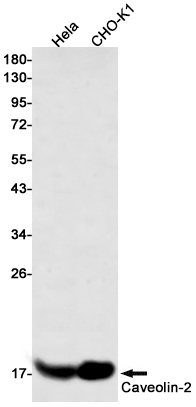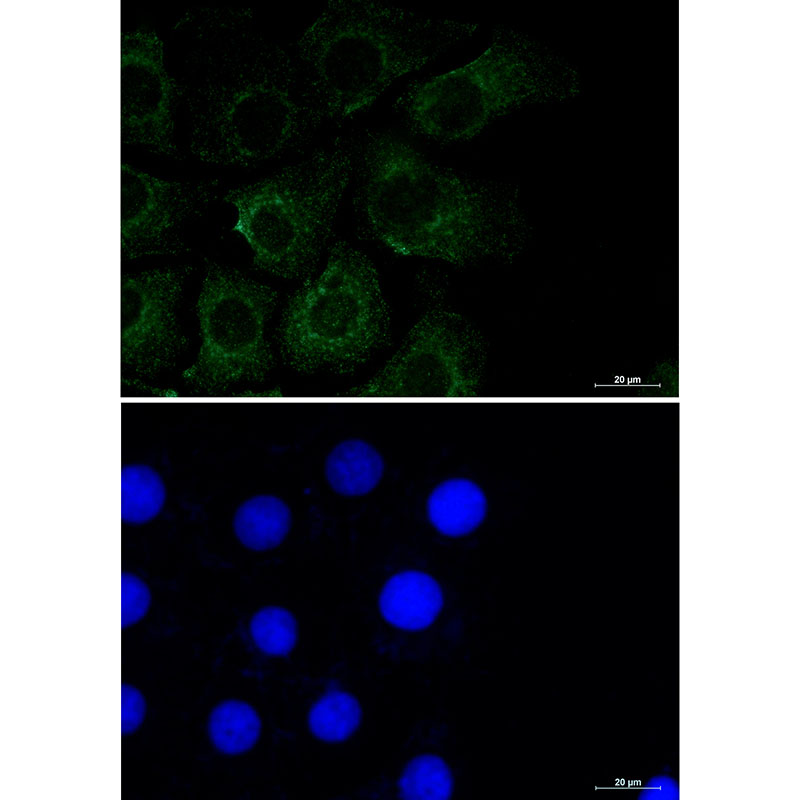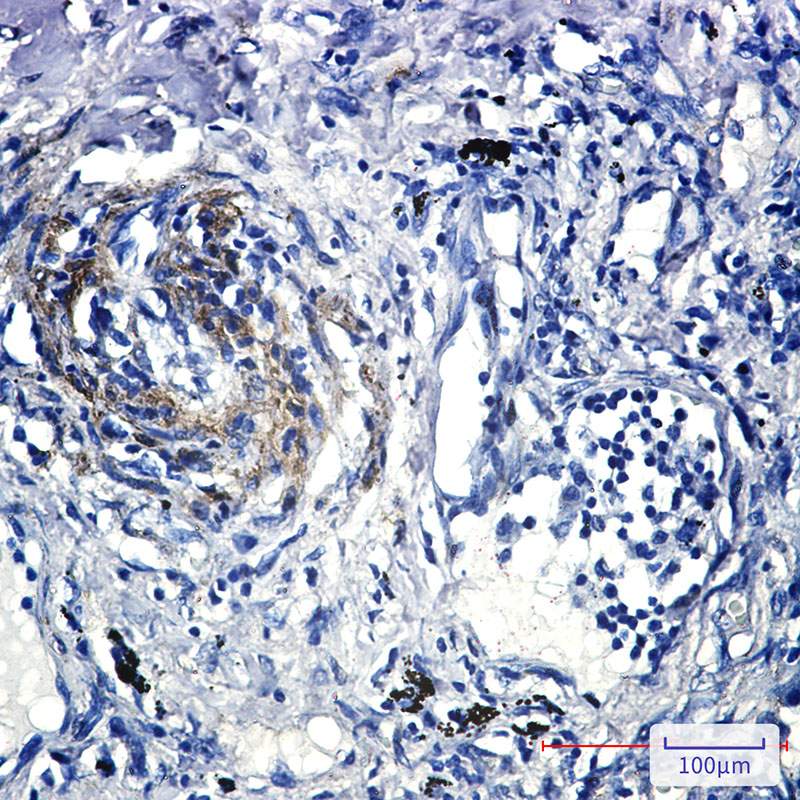


| WB | 咨询技术 | Human,Mouse,Rat |
| IF | 1/20 | Human,Mouse,Rat |
| IHC | 1/50-1/100 | Human,Mouse,Rat |
| ICC | 1/50-1/200 | Human,Mouse,Rat |
| FCM | 咨询技术 | Human,Mouse,Rat |
| Elisa | 咨询技术 | Human,Mouse,Rat |
| Aliases | CAV2; Caveolae protein 20 Kd; Caveolin 2; Caveolin 2 isoform a and b; Caveolin-2 |
| Entrez GeneID | 858 |
| WB Predicted band size | Calculated MW: 18 kDa; Observed MW: 18 kDa |
| Host/Isotype | Rabbit IgG |
| Antibody Type | Primary antibody |
| Storage | Store at 4°C short term. Aliquot and store at -20°C long term. Avoid freeze/thaw cycles. |
| Species Reactivity | Human |
| Immunogen | A synthetic peptide of human Caveolin-2 |
| Formulation | Purified antibody in TBS with 0.05% sodium azide,0.05%BSA and 50% glycerol. |
+ +
以下是3篇关于Caveolin 2抗体的代表性文献摘要:
---
1. **文献名称**: "Cell-type specific expression of caveolin-2 in fibroblasts and endothelial cells"
**作者**: Scherer, P.E. et al.
**摘要**: 该研究首次报道了Caveolin 2蛋白在成纤维细胞和内皮细胞中的特异性表达,并通过抗体检测发现其与Caveolin 1形成异源寡聚体,共同参与细胞膜穴样内陷(caveolae)的结构形成。
---
2. **文献名称**: "Caveolin-2 deficiency alters pulmonary function and protects against hyperoxia-induced injury"
**作者**: Razani, B. et al.
**摘要**: 利用Caveolin 2特异性抗体,研究揭示了Caveolin 2敲除小鼠的肺部表型,发现其在肺泡结构维持和氧化应激反应中的作用,抗体检测显示Caveolin 2缺失导致Caveolin 1表达下调。
---
3. **文献名称**: "Molecular cloning and tissue-specific expression of caveolin-2 interacting proteins"
**作者**: Okamoto, T. et al.
**摘要**: 通过免疫共沉淀结合Caveolin 2抗体,鉴定了多个与Caveolin 2相互作用的蛋白,并发现其在脂肪细胞分化过程中的动态表达变化,提示其参与代谢调控。
---
如需具体文献DOI或补充更多研究,可进一步说明需求。
Caveolin-2 is a member of the caveolin protein family, which plays a critical role in forming caveolae—small, flask-shaped invaginations of the plasma membrane involved in membrane trafficking, signal transduction, and lipid homeostasis. While Caveolin-1 is the principal structural component of caveolae, Caveolin-2 typically co-assembles with Caveolin-1 to form heterooligomeric complexes, enhancing membrane curvature and stability. Caveolin-2 is expressed in various tissues, including endothelial cells, adipocytes, and epithelial cells, and its function is closely linked to Caveolin-1. though its precise role remains less understood. Studies suggest it may regulate cellular processes like apoptosis, proliferation, and mechanoprotection.
Antibodies targeting Caveolin-2 are essential tools for investigating its expression, localization, and interactions in physiological and pathological contexts. They are widely used in techniques such as Western blotting, immunofluorescence, and immunohistochemistry to study Caveolin-2 distribution in tissues or cultured cells. Researchers employ these antibodies to explore its involvement in diseases like cancer, pulmonary fibrosis, and cardiovascular disorders, where dysregulation of caveolae-associated proteins is often observed. For example, reduced Caveolin-2 expression has been linked to tumor progression and endothelial dysfunction. Validation of Caveolin-2 antibodies requires specificity checks via knockout controls or siRNA knockdown to avoid cross-reactivity with other caveolins. Commercial antibodies are typically raised against conserved epitopes, ensuring reactivity across human, mouse, and rat models. Understanding Caveolin-2 dynamics through antibody-based assays continues to shed light on its biological significance and therapeutic potential.
×